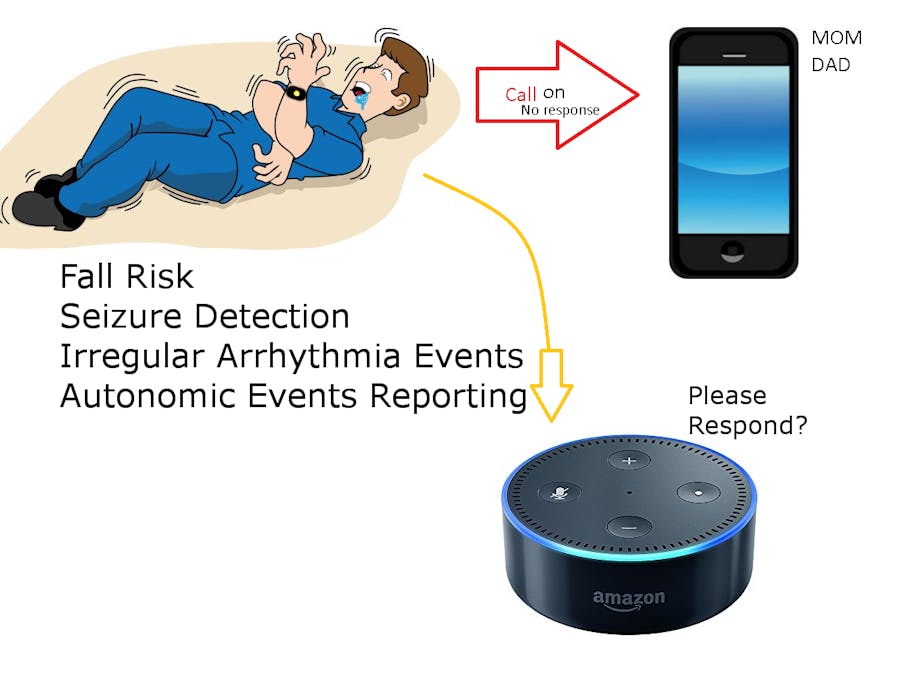Welcome To The Alexa Wristband Project
Hi my name is Kris, i've always been a strange but interesting individual. Hacking away in my in-home lab with the tools the internet has provided, expanding my knowledge by application and approach rather then studying and testing. I'd like to explain what it is im doing here quickly and straight to the point. So we can use our resources to benefit our outcome here on earth.
-Kris
What Is It
A wristband that detects seizures, comes equipped with a pulse, gyro sensor and connects to wifi to report events. What Is The Device Used For
- Fall Risk
- Seizure Detection
- Irregular Arrhythmia Events
- Autonomic Events Reporting
What It Can DoWhen the device detects a seizure,heart event,fall. Alexa will ask the user to respond. If there is no response the device will seek Medical help We have a layout and a test system in the works, the wristband sketch is in the development folder - Listed on GITWhere We've Come So FarCoding The Real - Time Notification PlatformThe Alexa / ECHO API, If used for what we are developing. The Alexa API will need to develop a NEW function for notifications to pass through without using context like "Im Reminding You" or require the user to ask what the notification is. so if there is a function integrated that can take text to speech and send it to alexa/ECHO without needing to be called on by a function - intent.We Need More Options ! More info about the problem found here...
and here
https://stackoverflow.com/questions/33409530/amazon-echo-push-a-message-to-the-device
The Code
There is nothing special here just a API that makes a call to a home server to send the request to Alexa, store's the user's data... Requirements - Library'sIPArduino .INO File Property
http://www.instructables.com/id/Wearable-heart-beat-sensor-ESP8266Pulse-sensor/
ARDUINO
- GYRO - mpu6050
- WIFI - esp
Direct Links
EDA - https://easyeda.com/kris193/Bionic_Controller-fa710b2fb0de45e5890d60f8d222c095
Drive - http://docs.google.com/document/d/1Pn-qL3KPpfgW_2eByCOJL4VaNJWr2PjLrmeETrg6gzk/edit?usp=sharing
GIT- https://github.com/givemesite/ALEXA-APP
The PHP & Arduino CODE
PHP
<?PHP
//////////////////////
// ALEXA //
// This is used to import all the lib's
// V0.0.2
// GMS INC 2018
//////////////////////
include ("./ALEXA.php");
//Fall Risk
//Seizure Detection
//Irregular Arrhythmia Events
//Autonomic Events Reporting
//////
?>
ARDUINO
//////////////////////
// This is used to import all the lib's
// V0.0.2
// GMS INC 2018
//////////////////////
/////////////////////////////
/////////
///////// Setup Loop
//
//
//The Includes Files
//#include <ESP8266WiFi.h>
//#include <Ticker.h>
/////////////////////////////
/////////
///////// Setup wifi
//
//
#include <ESP8266WiFi.h>
#include <Ticker.h>
//The Includes Files
//#include <ESP8266WiFi.h>
//#include <Ticker.h>
/////////////////////////////
/////////
///////// Setup Pin Trigers and Types
//
///*
MPU6050 Triple Axis Gyroscope & Accelerometer. Motion detection.
Read more: http://www.jarzebski.pl/arduino/czujniki-i-sensory/3-osiowy-zyroskop-i-akcelerometr-mpu6050.html
GIT: https://github.com/jarzebski/Arduino-MPU6050
Web: http://www.jarzebski.pl
(c) 2014 by Korneliusz Jarzebski
*/
#include <Wire.h>
#include <MPU6050.h>
//The Includes Files
//#include <ESP8266WiFi.h>
//#include <Ticker.h>
/////////////////////////////
/////////////////////////////
//Fall Risk
//Seizure Detection
//Irregular Arrhythmia Events
//Autonomic Events Reporting
//#include <ESP8266WiFi.h>
//#include <Ticker.h>
void setup() {
MPU6050 mpu;
Ticker flipper;
const int httpPort = 80;
Ticker sender;
const int maxAvgSample = 20;
volatile int rate[maxAvgSample];
// used to hold last ten IBI values
boolean sendok = false;
volatile unsigned long sampleCounter = 0;
// used to determine pulse timing
volatile unsigned long lastBeatTime = 0;
// used to find the inter beat interval
volatile int P =512;
// used to find peak in pulse wave
volatile int T = 512;
// used to find trough in pulse wave
volatile int thresh = 512;
// used to find instant moment of heart beat
volatile int amp = 100;
// used to hold amplitude of pulse waveform
volatile boolean firstBeat = true;
// used to seed rate array so we startup with reasonable BPM
volatile boolean secondBeat = true;
// used to seed rate array so we startup with reasonable BPM
volatile int BPM;
// used to hold the pulse rate
volatile int Signal;
// holds the incoming raw data
volatile int IBI = 600;
// holds the time between beats, the Inter-Beat Interval
volatile boolean Pulse = false;
// true when pulse wave is high, false when it's low
volatile boolean QS = false;
const char* ssid = "ssid";
const char* password = "password";
WiFiClient client;
const char* host = "192.168.1.80";//you pc IP
//MPU 6050
Serial.begin(115200);
Serial.println("Initialize MPU6050");
while(!mpu.begin(MPU6050_SCALE_2000DPS, MPU6050_RANGE_16G))
{
Serial.println("Could not find a valid MPU6050 sensor, check wiring!");
delay(500);
}
mpu.setAccelPowerOnDelay(MPU6050_DELAY_3MS);
mpu.setIntFreeFallEnabled(false);
mpu.setIntZeroMotionEnabled(false);
mpu.setIntMotionEnabled(false);
mpu.setDHPFMode(MPU6050_DHPF_5HZ);
mpu.setMotionDetectionThreshold(2);
mpu.setMotionDetectionDuration(5);
mpu.setZeroMotionDetectionThreshold(4);
mpu.setZeroMotionDetectionDuration(2);
checkSettings();
pinMode(4, OUTPUT);
digitalWrite(4, LOW);
pinMode(7, OUTPUT);
digitalWrite(7, LOW);
// End MPU 6050
// Start Wifi
Serial.begin(115200);
delay(10);
Serial.print("Connecting to ");
Serial.println(ssid);
WiFi.begin(ssid, password);
while (WiFi.status() != WL_CONNECTED) {
delay(500);
Serial.print(".");
}
Serial.println("");
Serial.println("WiFi connected");
Serial.println("IP address: ");
Serial.println(WiFi.localIP());
Serial.print("connecting to ");
Serial.println(host);
if (!client.connect(host, httpPort)) {
Serial.println("connection failed");
return;
}
//client.print("255");
delay(10);
Serial.println();
Serial.println("end Setup");
flipper.attach_ms(2, Test);
sender.attach(2, senderfunc);
}
void senderfunc()
{
sendok=true;
}
/////////////////////////////
/////////
///////// MAIN Loop
//
//
//
//
/////////////////////////////
void loop() {
// Start Sending BPM
if(sendok)
{
delay(100);
WiFiClient client;
const int httpPort = 80;
// to port to send the data
if (!client.connect("YOURPCIP", httpPort)) {
Serial.println("connection failed");
return;
}
//Serial.print("Requesting URL: ");
// This will send the request to the server
client.print(BPM);
Serial.println(BPM);
delay(10);
sendok =false;
flipper.attach_ms(2, Test);
}
}
void sendtcp()
{
}
int count = 0;
void Test()
{
count++;
if(count ==1000)
{
flipper.detach();
count =0;
//sendtcp();
sendok=true;
}
Signal = analogRead(A0);
// read the Pulse Sensor
sampleCounter += 2;
// keep track of the time in mS with this variable
int N = sampleCounter - lastBeatTime;
// monitor the time since the last beat to avoid noise
if(Signal < thresh && N > (IBI/5)*3){
// avoid dichrotic noise by waiting 3/5 of last IBI
if (Signal < T){
// T is the trough
T = Signal;
// keep track of lowest point in pulse wave
}
}
if(Signal > thresh && Signal > P){
// thresh condition helps avoid noise
P = Signal;
// P is the peak
}
// keep track of highest point in pulse wave
// NOW IT'S TIME TO LOOK FOR THE HEART BEAT
// signal surges up in value every time there is a pulse
if (N > 250){
// avoid high frequency noise
if ( (Signal > thresh) && (Pulse == false) && (N > (IBI/5)*3) ){
Pulse = true;
// set the Pulse flag when we think there is a pulse
//digitalWrite(blinkPin,HIGH);
// turn on pin 13 LED
IBI = sampleCounter - lastBeatTime;
// measure time between beats in mS
lastBeatTime = sampleCounter;
// keep track of time for next pulse
if(firstBeat){
// if it's the first time we found a beat, if firstBeat == TRUE
firstBeat = false;
// clear firstBeat flag
return;
// IBI value is unreliable so discard it
}
if(secondBeat){
// if this is the second beat, if secondBeat == TRUE
secondBeat = false;
// clear secondBeat flag
for(int i=0; i<=maxAvgSample-1; i++){
// seed the running total to get a realisitic BPM at startup
rate[i] = IBI;
}
}
// keep a running total of the last 10 IBI values
word runningTotal = 0;
// clear the runningTotal variable
for(int i=0; i<=(maxAvgSample-2); i++){
// shift data in the rate array
rate[i] = rate[i+1];
// and drop the oldest IBI value
runningTotal += rate[i];
// add up the 9 oldest IBI values
}
rate[maxAvgSample-1] = IBI;
// add the latest IBI to the rate array
runningTotal += rate[maxAvgSample-1];
// add the latest IBI to runningTotal
runningTotal /= maxAvgSample;
// average the last 10 IBI values
BPM = 60000/runningTotal;
// how many beats can fit into a minute? that's BPM!
QS = true;
// set Quantified Self flag
// QS FLAG IS NOT CLEARED INSIDE THIS ISR
}
}
if (Signal < thresh && Pulse == true){
// when the values are going down, the beat is over
//digitalWrite(blinkPin,LOW);
// turn off pin 13 LED
Pulse = false;
// reset the Pulse flag so we can do it again
amp = P - T;
// get amplitude of the pulse wave
thresh = amp/2 + T;
// set thresh at 50% of the amplitude
P = thresh;
// reset these for next time
T = thresh;
}
if (N > 2500){
// if 2.5 seconds go by without a beat
thresh = 512;
// set thresh default
P = 512;
// set P default
T = 512;
// set T default
lastBeatTime = sampleCounter;
// bring the lastBeatTime up to date
firstBeat = true;
// set these to avoid noise
secondBeat = true;
// when we get the heartbeat back
}
//sei();
// enable interrupts when youre done!

















_1x_bGT19vVAby.png?auto=compress%2Cformat&w=40&h=40&fit=fillmax&bg=fff&dpr=2)

_3u05Tpwasz.png?auto=compress%2Cformat&w=40&h=40&fit=fillmax&bg=fff&dpr=2)

Comments
Please log in or sign up to comment.